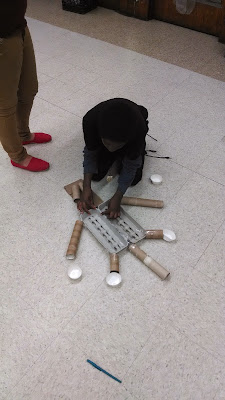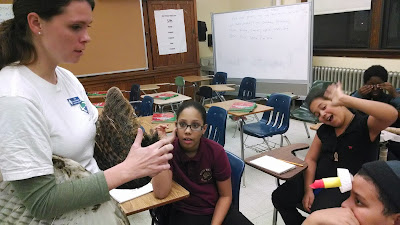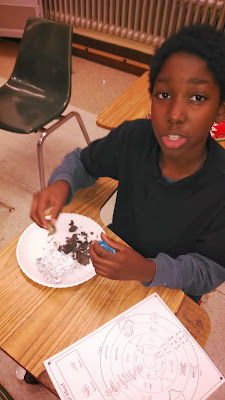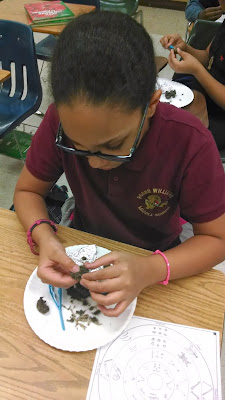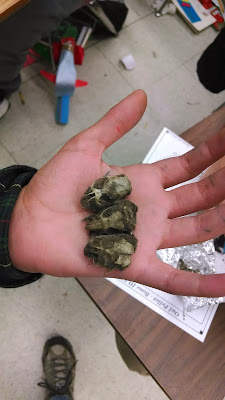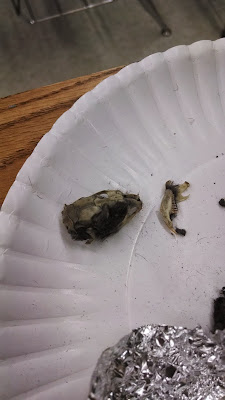Today, the Urban Naturalists learned how tracks and scat can tell us about the the animals and plants in an ecosystem. In most research situations, scientists don't usually see the animal, rather look for the evidence left behind!
Tracks occur when an animal's footprint gets left behind in their habitat. A great place to look for tracks is around a water source as the ground is usually squishy and wet and animals tend to gather their to drink. Tracks tell us what types of animals have been there, whether there was multiple in a group or a sole animal, and, sometimes, it tells us a story about the animals near the waterhole.
Scat is another word for animal poop! We can learn alot from poop! We can learn about what animals eat in the area, what types of animals are predators and prey, what gender the animal is, whether the animal is sick or healthy, and whether its a small or large animal in the area.
Marks and
Evidence are another way to learn about animals in the area. Looking for evidence of nests, burrows, fur shedding, remnants of something being eaten, chew marks or scratch marks on trees or leaves, etc., you can learn about what animals are in the area.
We learned about the tracks and scat of various animals and then investigated a "Critter Scene". We checked out a scene set up around a river bed. The Urban Naturalists were in charge of reading the landscape to see if they could figure out what happened around the river.
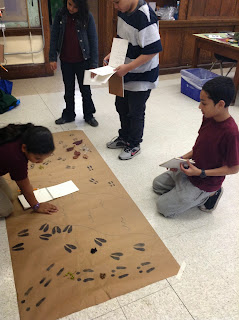 |
The Urban Naturalists survey
the scene |
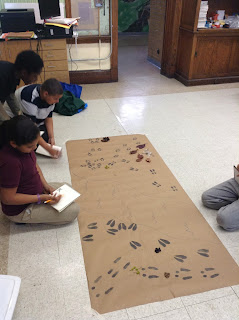 |
| Hmmmm...what happened here? |
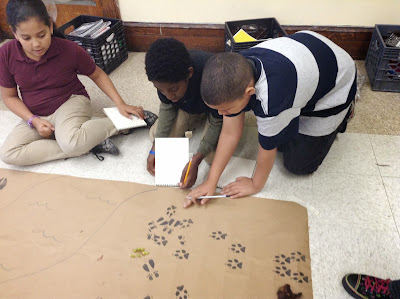 |
| Quentin and Jehudi focus on the dog tracks |
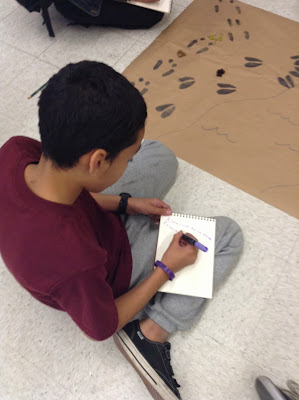 |
| Justin writes down his predictions |
The Urban Naturalists then came up with their predictions:
We came to the following conclusions:
Owl: There was an owl that was sitting in a tree, swooped down and grabbed a bird, ate the bird and expelled a pellet (the undigested bones and fur of an animal) We had evidence of this with an owl pellet, owl feathers and a pile of feathers left over from the bird
Rabbit: There was a rabbit who visited the river, but did not drink from it. The rabbit ate some food, pooped, and then seemed to hop away very quickly for some reason. We concluded it was probably running from something that was flying as there were no tracks chasing it. We figured this out by the tracks, poop, and food evidence.
Deer: A deer came to the river, drank, pooped, and then walked off. We knew this from the left over deer scat and deer tracks
Coyote: A coyote was hiding behind a bush when it spotted a squirrel who had been feasting on some nuts. The coyote bounded out of the bush and attacked the squirrel. The squirrel and coyote appeared to have a bit of a scuffle before the squirrel was killed and eaten. Only the coyote walks away from that scene. This is evident by the coyote poop, coyote tracks, and squirrel tracks.
Squirrel: A squirrel was bounding along until it found some nuts. It ate the nuts and was attacked and killed by a coyote. This is evident from the squirrel tracks and nut shells left over.
We then learned about "Misunderstood Animals" - animals people tend to dislike. These included sharks, bees, snakes, bats, rats, spiders and cockroaches! Emily taught us some amazing facts about these critters!
Emily then introduced us to an Audubon owl named Otie! He is an Eastern Screech owl with a fiesty attitude who is full grown! Emily taught us all about the group of birds he belongs to, called Raptors. Raptors are known for their excellent eyesight, huge claws (talons) and a sharp, curved beak. Raptors are fierce hunters!
